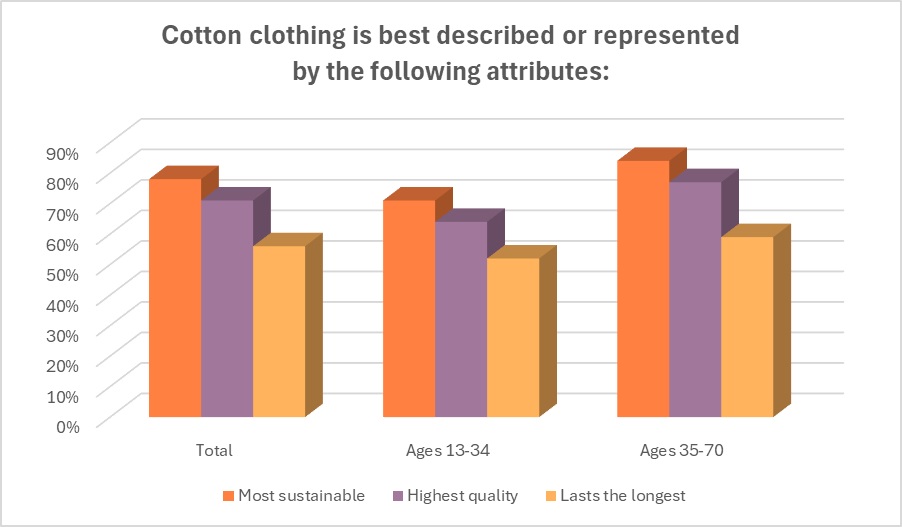There is no shortage of sustainability talk in the fashion industry, especially coming off Earth Month in April. But sustainability in the cotton industry starts in the field, where growers consider soil health, water cycling, nutrient management, and more as they embrace their role as stewards of the land.
Regenerative agriculture – which includes cover cropping, no-till or conservation tillage and crop rotation (more on this later) – is at the heart of the advancements in cotton growing, and it stands as a boon for brands and retailers that want to improve their sustainability goals.
Partnering to scale solutions that build community resilience are powerful ways to positively impact people’s lives, now and for the future.
Roseann Lynch, Chief People Officer & Head of the Ralph Lauren Corporate Foundation
“When we’re thinking about this idea of cotton production, we’re really thinking, ‘How does the soil sustain the crop and sustain the farmer and sustain the economy’,” says the Soil Health Institute’s Dr. Christine Morgan, chief scientific officer. “That’s the concept behind regenerative agriculture. It’s a system of farming principles and practices that seek to rehabilitate and enhance the entire ecosystem of a farm. But it places a premium and an emphasis on soil health.
“It also pays attention to those roles of biodiversity, socio-economic health of farmers and their communities,” Morgan continues. “If we perform regenerative agriculture, we’re enhancing the soil or getting back to where it was before we started plowing the soil.”
This idea of being eco-conscious literally from the ground level is one that resonates with consumers. Consider that nearly 7 in 10 apparel shoppers (69 percent) say they would be bothered if they found out a clothing item they purchased was not environmentally friendly, according to the Cotton Incorporated Lifestyle Monitor™ Survey. And there are repercussions for brands, as about 4 in 10 shoppers (39 percent) say they would hold the manufacturer responsible.
More than half of all consumers (53 percent) say a garment’s environmental impact is important to them, according to the Monitor™ research. And almost half (48 percent) say “environmentally friendly” clothing means apparel that’s not harmful to the environment/is good for the earth/is ethically sourced. Of note, the clear majority (78 percent) of consumers say cotton apparel is the most sustainable.

Researching and improving on an environmentally conscious approach to growing has its rewards. Cotton Incorporated and the U.S. Cotton Trust Protocol won the 2023 Field to Market Collaboration of the Year Award for the U.S. Cotton Trust Protocol: Collaborating for a Smarter Cotton Future project. The project is a cotton production assessment system established by U.S. cotton producers and industry organizations to provide a mechanism by which U.S. cotton growers can assess and verify their current production practices and measure progress toward long-term sustainability goals.
The award goes hand-in-hand with regenerative agriculture, some of the practices of which include cover crops, conservation tillage or no-till and crop rotation.
Cover crops are grown alongside cotton, and their canopy and roots reduce soil erosion, suppress weeds, enhance water availability, control pests and diseases, increase biodiversity and increase organic matter and carbon sequestration. Cover crops also improve soil structure so growers can cut back on irrigation.
Conservation tillage or no-till means growers reduce the number of times they till the soil – or they don’t till it at all – to decrease erosion, increase organic matter in the soil and increase soil carbon accumulation rates. Reduced tillage also significantly reduces fuel usage, benefitting both the environment and the growers’ costs.
Crop rotation involves strategically growing different crops in a specific sequence to enhance soil fertility, disrupt pest and disease cycles and improve soil structure. A grower might cycle out cotton with corn, soybeans or peanuts.
Since the U.S. Cotton Belt spans 17 states from Virginia to California and a multitude of soil types, ecosystems, and climates, the practices that are adopted by one grower might be quite different than those adopted by another. The idea is that each grower implements the practices that work best for their farm.
Forward-thinking brands and retailers are already incorporating regenerative agriculture into their programs. For instance, Target says it recognizes “the critical interconnections between climate and nature” and “is continuing to invest in regenerative agriculture.” As part of its efforts, Target is working with the U.S. Cotton Trust Protocol’s Climate Smart Commodities Projects to “build markets for climate-smart cotton and provide technical and financial assistance to over 1,000 U.S. cotton farmers.”
A few years ago, the Ralph Lauren Corporate Foundation gave a $5 million grant to the Soil Health Institute to launch the U.S. Regenerative Cotton Fund, an initiative that supports long-term, sustainable cotton production in the U.S.
“Partnering to scale solutions that build community resilience are powerful ways to positively impact people’s lives, now and for the future,” said Ralph Lauren Corporation’s Roseann Lynch, chief people officer and head of the Ralph Lauren Corporate Foundation, at the time of the program’s launch.
Clearly, these companies see the benefits of improved sustainability at the beginning of the supply chain. And that’s appreciated by consumers when they’re shopping for new clothes.
Nearly two-fifths of consumers (37 percent) say sustainability or environmental friendliness is important to them when they’re looking at what apparel brands to buy, according to Monitor™ research. And about half (49 percent) say environmental friendliness is an important factor when they’re actually making a clothing purchase.
Regenerative agriculture is a holistic approach to meeting the needs of the land, the farmer and the supply chain. The benefits bolster brands’ efforts to improve sustainability within their own supply chain. And when brands support regenerative agriculture, they gain a sustainability story worth sharing with both consumers and investors.
